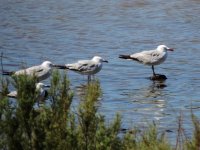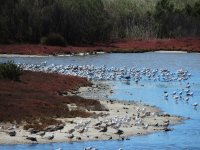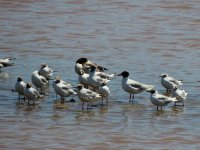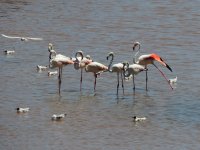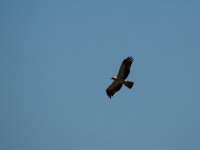Birding around Velez-Malaga with Quirri (2014.10.01)
Amazing amount and diversity of birds on passage like Dotterel, Northern Wheatear, Tawny and Tree Pipit, Whinchat, Redstart, Short-toed Lark, Yellow Wagtail, Pied Flycatcher, Sand Martin or Purple Heron.
It is worth devoting time to less frequented places, especially with those for whom they are very well known patches. And that is the case of Velez-Malaga and my friend Quirri, one of the best holistic naturalists one can find in... at least Spain.
We started at daybreak in the Campiñuelas, very humanized wide clayey plains to the east of the village, with scarce vegetation and surrounded by abandoned old olive groves. It is still hot here (23ºC by 7:00) but the day was pleasantly cloudy.
I soon could personally check Quirri’s accounts of the amount, diversity and rarity of the birds you can watch in the area.
Wheatears appear in such an amount, that you might well say “there is very much of them” instead of “there are many of them”, unbelievable. Plenty of Tawny Pipits and Short-toed Larks, also Redstarts, Whinchats, Rock Sparrows or Stone Curlews (in a flock of five) that may be very common in other latitudes and heights, but not that much so close to the sea. And also rarer friends like one Dotterel (flushed at some distance by somebody walking his dogs) and one Tree Pipit.
Another great point was the presence of seven Sylvia Warblers: Garden, Western Orphean, Sardinian, Spectacled (in quite a big amount!), Subalpine, Blackcap and Whitethroat.
List of birds observed in the Campiñuelas: Cattle Egret, Booted Eagle (dark morph), Kestrel, Stone Curlew, Dotterel, Wood Pigeon, Collared Dove, Turtle Dove, Little Owl, Hoopoe, Thekla Lark, Short-toed Lark, Barn Swallow, House Martin, Tawny Pipit, Tree Pipit, Yellow Wagtail, Grey Wagtail, Robin, Redstart, Wheatear, Whinchat, Stonechat, Blackbird, Blue Rock Thrush, Garden Warbler, Blackcap, Whitethroat, Western Orphean Warbler, Sardinian Warbler, Spectacled Warbler, Subalpine Warbler, Zitting Cisticola, Reed Warbler, Willow Warbler, Spotted Flycatcher, Pied Flycatcher, Great Tit, Iberian Grey Shrike, Spotless Starling, House Sparrow, Rock Sparrow, Chaffinch, Linnet, Goldfinch, Greenfinch, Serin and Cirl Bunting (48 species in total, not bad!).
We got to eat (and drink!) something in Velez at 15:00 and then moved to the port of La Caleta to watch shearwaters following the fishing boats arriving to the harbor. Some of the boats had already arrived but we could still see two of them with very nice views of the gulls and Balearic Shearwaters approaching the ships. I could also see my first Gannets of the season.
The additional species at the port were Balearic Shearwater, Gannet, Cormorant, Little Egret, Grey Heron, Mediterranean Gull, Yellow-legged Gull and Lesser Black-backed Gull (8 more species to the list).
And visiting the mouth of Rio Velez was a must once in the area. We first tried to spot some Tree Sparrows around the green houses but we were not lucky. Instead, we could watch a flock of Little Ringed Plovers and Cattle Egrets in the farmland and hear the first Cetti’s Warblers on our way to the river.
The hide near the river gave us a wonderful big flock of Red-rumped Swallows near the mouth. We could also see the famous ringed Red-knobbed Coot, some Mallards, Grey Herons and Green Sandpipers at the banks, with Kingfishers, Nigh Herons and several Sand Martins later on.
There were many more gulls at the beach, Sanderlings and one Scopoli’s Shearwater in the sea. Black Headed, Mediterranean and Audouin’s Gulls were resting in farmlands to the west of the river.
We stayed in the hide until dusk to observe the big roosting flock of Cattle Egrets, also joined by seven Night Herons and two Purple Herons.
Additional species at Rio Velez: Mallard, Teal, Scopoli’s Shearwater, Night Heron, Purple Heron, Moorhen, Coot, Red-knobbed Coot, Little Ringed Plover, Ringed Plover, Sanderling, Green Sandpiper, Black-headed Gull, Audouin’s Gull, Kingfisher, Sand Martin, Red-rumped Swallow, White Wagtail and Cetti’s Warbler (19 more species to the list).
The number of species detected in this wonderful day ads up to 75!
Thank you, Quirri, for such a tiring but productive and enjoyable birding day.


